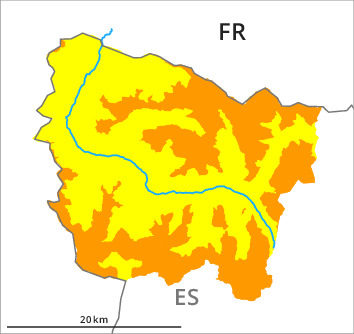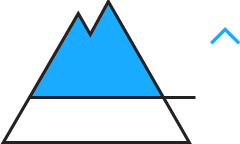
Danger level

2000m
Avalanche Problem

Wind-drifted snow

2000m


Persistent weak layer

2100m


Wind slabs and weakly bonded old snow are to be critically assessed. The number and size of avalanche prone locations will increase as the day progresses.
As a consequence of new snow and a moderate to strong wind from variable directions, avalanche prone wind slabs will form in the course of the day in all aspects. The avalanches can over a wide area be released by a single winter sport participant and reach medium size. The avalanche prone locations are to be found in particular in steep terrain at intermediate and high altitudes and adjacent to ridgelines and in gullies and bowls. In the valleys of Molières and Conangles and in the valleys of Ruda, Aiguamòg and Valarties these avalanche prone locations are more prevalent.
The older wind slabs can be released by a single winter sport participant in isolated cases in all aspects above approximately 2100 m, especially at their margins. Avalanches can be triggered in deep layers and reach medium size. Remotely triggered and natural avalanches are possible in isolated cases. Transitions from a shallow to a deep snowpack where hard layers are lying on a weakly bonded old snowpack are especially dangerous.
The older wind slabs can be released by a single winter sport participant in isolated cases in all aspects above approximately 2100 m, especially at their margins. Avalanches can be triggered in deep layers and reach medium size. Remotely triggered and natural avalanches are possible in isolated cases. Transitions from a shallow to a deep snowpack where hard layers are lying on a weakly bonded old snowpack are especially dangerous.
Snowpack
>In the south 20 to 30 cm of snow, and even more in some localities, will fall. In the other regions 15 to 20 cm of snow will fall. The wind will be moderate to strong over a wide area.
In some places wind slabs are lying on old snow containing large grains. Released avalanches and stability tests confirm the unfavourable bonding of the snowpack in particular adjacent to ridgelines in all aspects.
The current avalanche situation calls for extensive experience in the assessment of avalanche danger and careful route selection.
In some places wind slabs are lying on old snow containing large grains. Released avalanches and stability tests confirm the unfavourable bonding of the snowpack in particular adjacent to ridgelines in all aspects.
The current avalanche situation calls for extensive experience in the assessment of avalanche danger and careful route selection.
Tendency
Hardly any decrease in avalanche danger as a consequence of the ceasing of precipitation.